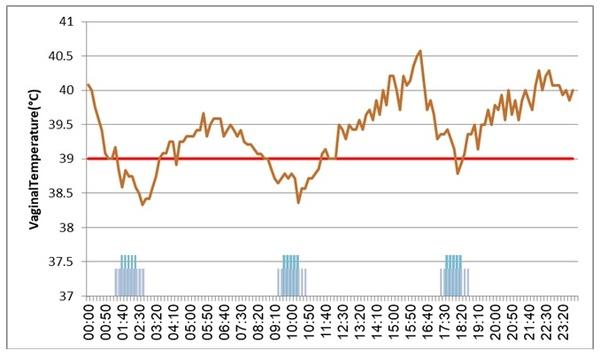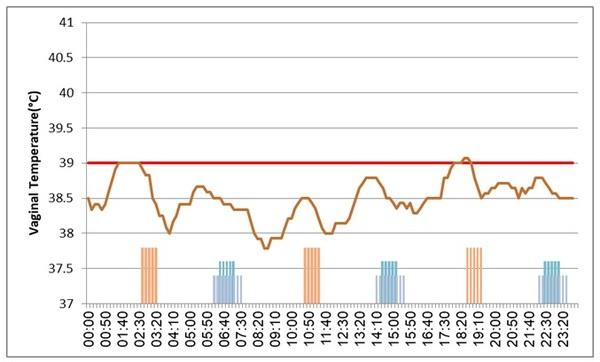Continuous monitoring of cow's body temperature, an important tool to optimize cooling treatment in the summer
Published: March 22, 2024
By: Israel Flamenbaum, Ph. D / Cow Cooling Solutions Ltd, Israel.
Monitoring and transmitting in real time and continuous manner the body temperature of the cows has become a reality these days. This can improve the effectiveness of cooling treatments given to the cows, with all the benefits that can arise from that. The following article presents the knowledge and experiences accumulated in the last years in Israel, based on monitoring cow's body temperatures, using intravaginal data loggers.
In one of my first cooling projects, carried out on a large-scale dairy farm, we inserted intravaginal data loggers in the summer to a group of 30 cows, cooled by a combination of wetting and forced ventilation. Cooling was provided in the waiting yard, before each milking session. In the beginning, cows were cooled for three cumulative hours per day (one every eight hours). In figure 1, we can see the body temperature of cows receiving this treatment.
Figure 1 - Vaginal temperature throughout the day, when cows were cooled for 3 cumulative hours per day, one hour before each milking session and every 8 hours (blue columns represent cooling time).

As can be seen in figure 1, cows in such cooling regime were not sufficiently cooled, and spent most of daytime in body temperature above 39.0 C, which is considered as the threshold for being in heat stress. Due to these poor results, we decided to double the cooling time, by providing cows tree additional cooling treatments, and in total, 6 treatments per day (one every 4 hours). The results can be seen in figure 2.
Fig. 2 - Vaginal temperature throughout the day, when cows were cooled for 6 cumulative hours per day, before and between each milking session, one cooling session every 4 hours. (The blue columns represent cooling treatment provided before each milking session and orange columns represent cooling treatments provided between milking sessions).

As can be seen in figure 2, cooling the cows for six cumulative hours per day, one hour of cooling treatment every four, can keep cows at normal body temperature for the entire day.
In parallel to this experience, a research was carried out in the experimental dairy farm of the Ministry of Agriculture of the state of Israel. Behavioral and performance traits of cows being cooled for 3.5 cumulative hours per day, in 5 cooling sessions of 45 minutes each, was compared to that of cows cooled for 6 cumulative hours per day, in 8 cooling treatments of 45 minutes each. (Honig et. al, JDS 95:3737, 2012). The results are presented in table 1.
Table 1 – Feed consumption, milk production, resting and ruminating time of cows cooled 5 times per day, for 3.5 cumulative hours (5T), or 8 times per day, for 6 cumulative hours (8T).

From the presented in Table 1 it can be clearly seen that cooling the cows for six cumulative hours per day, which probably allowed them (as could be seen in the study presented earlier in this article), maintain normal body temperature in the entire day. This was translated to an increase in cow's resting and ruminating time, as well as feed consumption and milk production.
The data presented above represents the results reached by cooling the cows in intensities that probably are difficult to be achieved in common commercial dairy farms. Usually, the situation in these farms is not as good, and cows in farms implementing cooling means, experience some hours per day in which, their body temperatures exceed the threshold. No doubt that continuous monitoring cow's temperature, as presented in figures 1 and 2, can allow farmers optimize their cooling treatment. Anyhow, there is still the question of what will be the impact on cows, from being in body temperatures above threshold, for certain time along the day.
An answer to this question can come from a study carried out by researchers from the Israeli Ministry of Agriculture Research Institute, who examined the relation between the number of hours per day cows experience heat stress and their fertility traits when inseminated in the summer. Intravaginal data loggers were inserted into 32 cows, in each of 12 farms, located in the central part of Israel. Data loggers were inserted for two periods of 3 days each during the summer (July – September). Based on the data obtained, farms were classified in tree groups, according to the number of hours per day that cow's vaginal temperature exceeded the threshold of 39 C. Conception rates for inseminations given in that summer, in the tree groups of farms are presented in table 2.
Table 2 – Conception rate from inseminations given in the summer, in farms where cow's vaginal temperatures exceeded threshold for short, medium and long period of time during the day.

As can be seen in table 2, farms whose cows where with body temperature above threshold for 4.4 hours per day, reached summer conception rete of 33%, almost double of the conception rate in farms where cows experienced 9.7 hours per day with body temperature above threshold. The level of 33% CR achieved in this study, is close to the obtained by "good cooling" farms" in Israel, whose "summer to winter milk production ratio index" was close to 1.0 (Famenbaum et. al., J. of Reproduction and Development Vol. 56, 2010), and was less than 10 percentage units of conception rate below winter level. The question remains, whether cows in complete thermal comfort (bellow 39 C for the entire 24 hours), could reach a complete erasure of the conception gap between winter and summer. Giving an answer to this question will be possible, only when being able to monitor body temperatures in a continual form in large number of cows.
Expanding the use of advanced means for continuous monitoring of body temperature in large number of cows, as well as being able to process and transmit this data in digital form, have the potential to improve the effectiveness of cooling treatments. At the same time, it will allow get an answer to the question if cows can experience certain hours in the day, being in body temperature above threshold, without this negatively affecting their performance. Such information may be of great economic value, resulting from the possibility to reduce the time of operation of cooling system, save expenses, and improve farm profitability.
Related topics:
Authors:
Recommend
Comment
Share
Recommend
Reply

Would you like to discuss another topic? Create a new post to engage with experts in the community.





.jpg&w=3840&q=75)